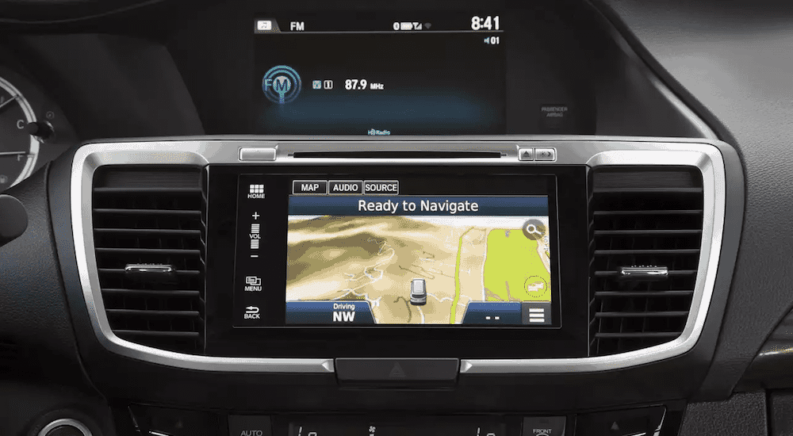Recently, I wrote a comparison piece focused around two ill-fitting models; the first, an import model that had been introduced 30 years prior to the second – a relatively new domestic offering. Comparing it to 40-year old challenging a 70-year old to a race, it was not dissimilar to seeing how apples measured up against oranges and, ultimately, it was an exercise in minutiae.
That said, it will be interesting to compare the 2017 Honda Accord vs 2017 Hyundai Sonata. Both mid-century companies from Japan and South Korea, respectively, Honda and Hyundai were serious players in the import surge of the 1980s. So finding ourselves measuring the 30-40 year offerings of their most prominent midsize sedan offerings, we wonder: will there be a clear standout, or will we find ourselves focused on a different kind of minutiae?
Starting in the most obvious place (your wallet), the Accord starts around $22,455 MSRP and the Sonata falls in lower with an MSRP of $22,050. And while a 10% difference in ticket price is noteworthy, does it impact what the buyer can expect to receive?
Performance
Starting with Honda, the (base) LX trim of the Accord is powered by a 2.4-liter four cylinder engine, that delivers 185 horsepower and 181 lbs-ft of torque. You can opt for either a six-speed manual or a (CVT) continuously variable automatic transmission. If choosing the latter, expect an estimated fuel economy of 32 mpg (highway, 23 city).
The Hyundai Sonata is close to mirroring this, with the base trim powered by (you guessed it) a 2.4-liter four-cylinder engine. Offering up 185 horsepower and 178 lbs-ft of torque, these two are basically neck-and-neck. Even an estimated fuel economy of 36 mpg (highway, 25 city) is only marginally higher.
Both offer additional options for engine configuration at higher trims. The major disparity comes into play when discussing the overall driving experience, from handling to acceleration, to steering and breaking. The Sonata simply falls short in terms of engaging the driver. While it’s certainly a well-balanced vehicle with comparable engine specs, it’s not as fun to drive as the Accord; and for that reason, Honda takes the point. (1:0 Honda).
Exterior Design
I always like to emphasize my belief in the subjective nature of aesthetics, when talking about exterior design. What is appealing to me, may not be appealing to you, and vice versa. While that’s okay, we do our best to judge every vehicle on the merits of its own design.
In terms of overall styling, the Accord appears to favor classic sedan styling. While some might find fault with this no-frills approach, the real impact of such a design decision is found in the front end. By simplifying the profile, all eyes shift to a head-on look and, in this sense, the Accord is very successful. It’s aggressive front-end infuses its classic design with a more edgy, modern feel.
Once again the Hyundai shares certain design sensibilities, with a wide hexagonal grille injecting modernism into an otherwise classic design, which leads us to the subjective part of our conversation.
While the Sonata has a refined, almost luxury-inspired look to its front fascia, that of the Accord conveys a mixture of athleticism and aggression. The fact that it looks leaner and meaner, may not mean much to you but, in my opinion, it’s enough to give the Accord an even stronger lead. (2:0 Honda)
Interior Design
While it’s a matter of preference, I feel that elongation as a recurring design theme adds a more high-end look to any vehicle (especially sedans). With that in mind, kudos to both Honda and Hyundai for adopting this approach in the Accord and Sonata.
Both cabins are nicely designed, with ample room for adult passengers. Placement of controls and gauge clusters in both cars reflect thoughtful intent, encouraging a driver-centric experience. And (at the base level trim) material choices for both are good, although those used in the Accord read as slightly higher in terms of quality.
While both the Accord and the Sonata can be enhanced courtesy of jumping to higher trim levels, the Accord is simply a better blend of modern design and quality materials. So, with that in mind (3:0 Honda).
Technology
The (base) LX trim of the Accord is Bluetooth-enabled, with an infotainment system based around a 7.7-inch display screen (with rear camera), and a four-speaker sound system. Keeping in mind that this is ‘display only,’ the touchscreen comes into play at higher trim levels. But the voice controls are both responsive and well-designed. Music options are plentiful with CD, auxiliary, and USB inputs, enhancing the streaming options offered by Apple CarPlay and Android Auto.
Honda also puts safety first, making their Honda Sensing features standard from the base-level up. Including the likes of adaptive cruise control, collision and lane departure warnings, these driver assist aids are a welcome addition.
Truth be told, in-cabin technologies are another area where the Accord and Sonata find themselves in shared territory. Like the Accord, the Sonata is Bluetooth-enabled, with a versatile infotainment system that offers the full gamut of music sources. The one area where it lags behind is in terms of safety features (which become standard at higher trim levels). What does come standard is Hyundai’s emergency telematics system, which offers emergency support, as well as programmable features for parents of teen drivers.
And since Honda doesn’t offer the latter, let’s consider it a one-to-one trade, and call this round a tie. (4:1 Honda)
Results
While both the Accord and the Sonata offer a wealth of enhancements at higher trim levels, the base models fall very close to one another. In fact, it’s close enough across the board where it really comes down to personal tastes.




